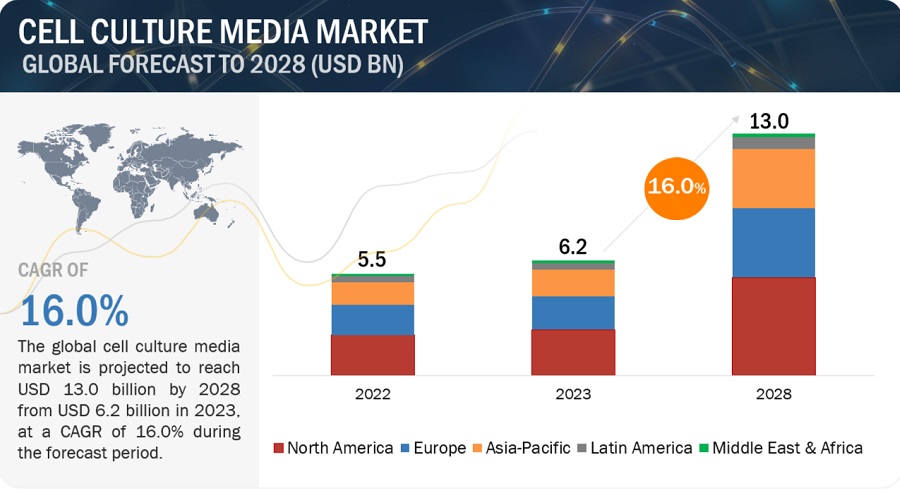The global cell culture media market in terms of revenue was estimated to be worth $6.2 billion in 2023 and is poised to reach $13.0 billion by 2028, growing at a CAGR of 16.0% from 2023 to 2028.

Download an Illustrative overview:
https://www.marketsandmarkets.com/pdfdownloadNew.asp?id=97468536
Browse in-depth TOC on “Cell Culture Media Market”
359 – Tables
42 – Figures
315 – Pages
In 2022, the serum-free media segment accounted for the largest share of the type segment in the cell culture media market.
On the basis of type, the cell culture media market is divided into serum-free media, classical media & salts, stem cell culture media, specialty media, chemically defined media, and other cell culture media. In 2022, the serum-free media segment holds for the bigest share of the market. Factors responsible for the growth of this segment includes various advantages or benefits of serum-free media over other types of cell culture media.
In 2022, the biopharmaceutical production segment accounted for the largest share of the application segment in the cell culture media market.
On the basis of application, the cell culture media market is categorized into biopharmaceutical production, diagnostics, drug discovery & development, tissue engineering & regenerative medicine, and other applications. The biopharmaceutical production segment is estimated to grow at the highest growth rate during the forecast period. Factors responsible for the growth include, the growing production of cell culture-based vaccines, and expansion of pharmaceutical industry. The biopharmaceutical production applications of cell culture media include the manufacturing of biologic-based products such as vaccines, monoclonal antibodies, and other therapeutic proteins (such as anticoagulants, enzymes, blood factors, hormones, interferons, growth factors, interleukins, engineered proteins, and thrombolytics, among others).
In 2022, the Asia Pacific region is the fastest-growing region of the cell culture media market.
On the basis of the region, the global cell culture media market has been segmented into North America, Europe, the Asia Pacific, Latin America, and the Middle East and Africa. During the forecast period, the Asia Pacific market is estimated to register the highest CAGR during the forecast period. Increased focus of key market players on geographical expansion in emerging markets, favorable government policies and support for cell-based vaccines in the region and less manufacturing cost are some of the major factors anticipated to have positive impact on the market growth of Asia Pacific region.
Request Sample Pages:
https://www.marketsandmarkets.com/requestsampleNew.asp?id=97468536
Key Market Players:
Key players in the cell culture media market include Thermo Fisher Scientific, Inc. (US), Merck KGaA (Germany), Danaher Corporation (US), Sartorius AG (Germany), Corning Incorporated (US), FUJIFILM Irvine Scientific, Inc. (Japan), Lonza Group AG (Switzerland), Becton, Dickinson and Company (US), Miltenyi Biotec (Germany), and among others.
Recent Developments:
- In June 2023, Thermo fisher launched Tumoroid Culture Medium to accelerate development of novel cancer therapies.
- In April 2023, FUJIFILM Irvine Scientific launched BalanCD CHO Media Platform Portfolio for Bioprocessing.
- In March 2022, FUJIFILM Irvine Scientific acquired Shenandoah Biotechnology. The deal would help the company to provide customers with a single point of access for their life science research, discovery, and cell and gene therapy needs.
- In January 2022, Cytiva and Nucleus Biologics LLC collaborated to enhance custom cell media development for cell and gene therapies.
Cell Culture Media Market Advantages:
- Versatility: Cell culture media provide a versatile platform for the growth and maintenance of various types of cells, including primary cells, stem cells, and cell lines derived from different tissues and species. This versatility allows researchers to study and manipulate diverse cell populations, facilitating a wide range of applications in basic research, drug discovery, and regenerative medicine.
- Reproducibility: High-quality cell culture media formulations are standardized and extensively tested, ensuring consistent and reproducible results across different experiments and laboratories. This reliability is essential for generating meaningful and reliable data, which is critical for the advancement of scientific knowledge.
- Customizability: The cell culture media market offers customizable formulations to cater to specific cell types and experimental requirements. Researchers can optimize media components to suit the unique needs of their cells, enhancing cell growth, proliferation, and differentiation, ultimately leading to more accurate and reliable experimental outcomes.
- Scalability: Cell culture media have been developed to support large-scale production of cells, making them integral to biopharmaceutical manufacturing. With the increasing demand for cell-based therapies and biologics, scalable media solutions play a vital role in ensuring the efficient and cost-effective production of therapeutic cells and products.
- Safety and Purity: High-quality cell culture media are manufactured under stringent quality control standards to ensure the absence of contaminants that may compromise cell viability or introduce experimental artifacts. These safety measures are essential to maintain the integrity of research findings and the safety of biopharmaceutical products.
- Reduced Dependency on Animal Models: Advanced cell culture media formulations have contributed to reducing reliance on animal models in research, as they allow scientists to conduct more relevant experiments using human or cell-based models. This ethical advantage aligns with the growing focus on reducing animal testing while still advancing scientific progress.
- Technological Advancements: The cell culture media market continually evolves, incorporating technological advancements, such as serum-free or xeno-free formulations, to improve cell culture systems’ efficiency and reproducibility. These innovations empower researchers to work with more physiologically relevant and defined conditions, yielding results that better translate to clinical applications.
- Accelerated Drug Discovery: Robust cell culture media accelerate drug discovery processes by enabling high-throughput screening of potential drug candidates on various cell models. This expedites the identification of promising compounds, shortens development timelines, and reduces drug development costs.
- Overall, the cell culture media market’s advantages have revolutionized modern biomedical research, playing a pivotal role in advancing scientific knowledge, drug development, and regenerative medicine, while contributing to the growth of the biotechnology and pharmaceutical industries.
